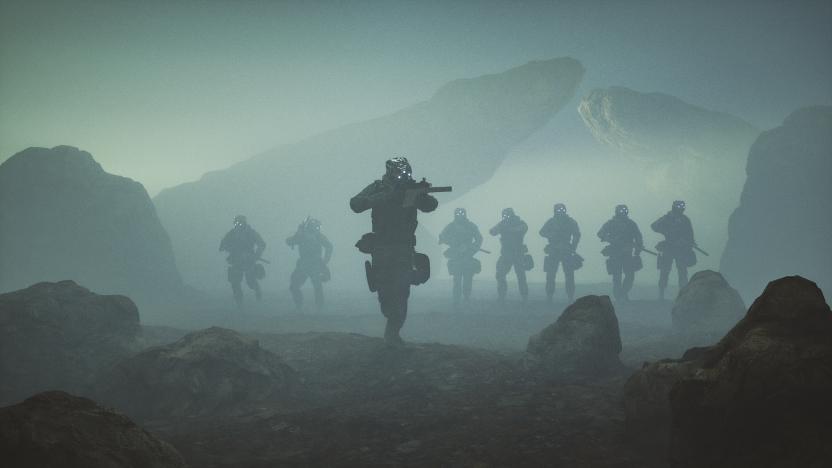us military
Latest

An email typo has reportedly sent millions of US military messages to Mali
A typo has reportedly routed millions of US military emails — some containing highly sensitive information — to Mali. The problem stems from entering .ML instead of .MIL for the receiving email address domain. As reported by the Financial Times, the one-letter mistake has exposed data like “diplomatic documents, tax returns, passwords and the travel details of top officers” — and much more. Although the misdirected emails have (so far) landed with a contractor tasked with managing Mali’s country domain, control of .ML will soon revert to Mali’s government, which has ties to Russia.

Palantir shows off an AI that can go to war
Palantir, the surveillance company founded by billionaire mogul Peter Thiel, wants to get in on America's Forever War action.

Biometric devices sold on eBay reportedly contained sensitive US military data
German researchers who purchased biometric capture devices on eBay found their memory cards stored a US military database containing sensitive data.

Recommended Reading: Apple's AR secret weapon is already in your pocket
Recommended Reading highlights the week's noteworthy writing on technology and more.

Amazon discounts Prime subscriptions by $40 for veterans
With Veterans Day coming up, Amazon has launched a new promotion aimed at armed forces members. Starting today and until November 11th, if you've served in the military, or are a current active duty or reserve member, you can get $40 off the first year of an Amazon Prime subscription. If you're already a subscriber, fret not: you can use the promotion as a way to extend your membership at a discount.

Disposable delivery drones pass test with US Marines
The US military is testing delivery drones that can transport supplies over long distances and be thrown away after each use. Made of cheap plywood, the bigger version of the two gliders being tested can carry over 700 kilograms, or roughly 1800 pounds. As reported in IEE Spectrum, the scientists at Logistic Gliders, Inc. revealed that their gliders just successfully completed a series of tests with US Marines. If cleared for mass production, the LG-1K and its bigger counterpart, the LG-2K, could cost as little as a few hundred dollars each.

DARPA threat detection technology uses a camera to see targets, software and soldier brains to identify them
DARPA aids our military in myriad ways, from designing one shot, one kill weapons to creating robotic pack mules to carry soldiers' gear. It's also been building tools for soldiers to better survey their environment and identify threats, and its latest such tool is called the Cognitive Technology Threat Warning System (CT2WS). CT2WS is comprised of a 120-megapixel electro-optical video camera with a 120-degree field of view feeding a laptop running cognitive visual processing algorithms. Those algorithms identify potential targets in the video feed, which are shown to a soldier wearing an EEG cap that monitors brain signals. You see, the human brain is particularly good at perceiving threats, and CT2WS looks for the particular brain wave that occurs when we see one. The human component drastically improves the accuracy with which the system can identify enemies from afar. How accurate? Testing in desert, tropical and open terrain showed that without a solider/EEG filter, the system had 810 false alarms out of 2,304 threat events in an hour. Incorporating the filter resulted in only five false alarms per hour, plus it was able to identify 91 percent of the potential targets successfully. Not good enough, you say? Add commercial radar into the mix and the army becomes omniscient -- the system then identified 100 percent of the test targets.

Confirmed: AT&T offers complimentary unlock of in-contract iPhones for deployed military personnel
Finally. A bit of closure. AT&T has confirmed the long-lived speculation of its policy to unlock in-contract iPhones for our military men and women deployed overseas. To qualify for the complimentary service, active military members must have an account in good standing and provide the carrier with deployment verification -- that's it, no other hoops to jump through. The revelation was made today as part AT&T's new Device Unlock Portal, which allows off-contract iPhone owners to apply online to have their handsets unlocked. Previously, this unlock service was available only through the carrier's retail outlets, online chat support or by dialing 611. As a quick rehash of the non-military policy, all users -- either current or former AT&T subscribers -- must have completed their contractual obligations to AT&T, and the phone cannot be flagged as lost or stolen. All those eligible should certainly apply for the service, as an unlocked iPhone is infinitely more useful when traveling abroad -- a reality that deployed military members know all too well. [Military photo via Shutterstock]

Military hunting smartphone safety to hold off enemy bugs, spooks
Ah, smartphones -- the delightful little slates carry our contacts, our content -- even our cash, and they still fit right in our pockets. No surprise then, that a lost or stolen phone can be a minor disaster -- or a major security risk (just ask the President). Now that soldiers are packing them to send GPS coordinates or situational images in the field -- on top of using them at home -- DARPA has enlisted security company Invincea to fortify the devices. Its first effort, encrypting OS files and filling the memory of a lost phone with worthless data, has already been deployed to 3,000 troops in Afghanistan. Its next target is to cloister apps into virtual rooms within the OS, locking off access to sensitive parts of the phone like its GPS or contact lists. That would keep any nasty bits of malware from potentially gaining root privileges so soldiers can fight, and Facebook, without compromise.

US military looking to create a 'universal remote' for drone fleets
When you've got as many different drone models as the US military, it can be hard to manage things. That's why a group inside the Pentagon is looking to help cut down on unmanned aerial fragmentation, attempting to develop a way to manage all of the different models with a universal drone controller. It's something the military has tried and failed to accomplish in the past, but this time it's taking a more smartphone-esque approach to the matter, according to Wired. The key would be to create an underlying software architecture that allows pilots to control fleets of unmanned vehicles. On top of that would be specific applications that are "down-loaded to suit individual user taste and productivity," a Pentagon official told the site. The approach would make it possible to control different models with differing functionality as a connected fleet.

Navy looks into UV cloak for stealth aircraft
The Navy's invested good money in the F-35 Joint Strike Fighter, which obscures radar waves and redirects engine heat to evade recognition by infrared sensors. But that stealth flier is still vulnerable to another type of detection: UV sensors. The Pentagon recently began soliciting proposals to develop a device that cloaks aircraft from ultra-violet detection systems. The hope is that such a technology could shield aircraft from missile seekers that scan the sky for telltale "UV silhouettes." According to the call for research, the solution could involve a device that disperses a cloud of quantum dots or other materials to veil jet fighters in a shapeless mass of UV shadow. Given that this is a rather daunting task, it's not surprising that the development timeframe and projected cost are still up in the air.

AT&T purportedly unlocks in-contract iPhones for deployed military personnel
AT&T has gotten a good amount of attention lately for unlocking off-contract iPhone handsets, but a recent report from MacRumors suggests that the carrier is extending the same privilege to members of the US military currently serving overseas. While we haven't been able to verify the report, we'd like to believe that news of AT&T's goodwill gesture is indeed genuine. Naturally, we're rather curious to know whether this policy extends to AT&T's entire range of handsets. So, if you or a loved one is on active deployment, be sure to give this a try and let us know your experience in the comments below.[Military photo via Shutterstock]

U.S. Department of Defense preps cyber rules of engagement, plans to work more closely with ISPs
The Pentagon left no room for argument last year when it declared cyber attacks a potential act of war. "If you shut down our power grid, maybe we will put a missile down one of your smokestacks," a military official reportedly remarked. Yikes. Before we start bombing chimneys, however, the Department of Defense plans to draft up some relevant guidelines, noting in a recent House Armed Services Committee hearing that it will be delivering a set of cyberspace-specific rules of engagement in the coming months. "We are working closely with the joint staff on the implementation of a transitional command and control model for cyberspace operations," said Madelyn Creedon, assistant secretary of defense for Global Strategic Affairs. In addition to setting ground rules for cyber-engagements, the DOD also plans to expand efforts to share classified information on possible threats with internet service providers and defense contractors.

Navy tests bacteria-powered hydrogen fuel cell, could start monitoring your underwater fight club
Microbial fuel cells aren't exactly new, but microbial fuel cells scouring the ocean floor? Now that's an initiative we can get behind. The Naval Research Laboratory is currently toying around with a so-called Zero Power Ballast Control off the coast of Thailand, presumably looking for treasures dropped from the speedboat of one "Alan Garner." Purportedly, the newfangled hydrogen fuel cell relies on bacteria to provide variable buoyancy, which allows an autonomous ocean sensor to move up and down water columns with little to no effort. Furthermore, it's able to get its energy from microbial metabolism (yeah, we're talking about hot air), and while it's mostly being used to measure things like temperature and pressure, it could be repurposed for more seirous tasks -- like mine detection. There's no clear word yet on when America's Navy will have access to this stuff, but if we had to guess, they've probably be using it behind our backs for the better part of a score. [Image courtesy of U.S. Navy Reserve / Tom Boyd]

Pentagon says cyber attacks are acts of war: send us a worm, get a missile in return?
Well, the Pentagon is finally fed up with hackers picking on its buddies and foreign intelligence taking shots at its computer systems, and has decided that such cyber attacks can constitute an act of war. Of course, the powers that be won't be bombing you for simply sending them some spyware, but attempts to sabotage US infrastructure (power grids, public transit, and the like) may be met with heavy artillery. It's unclear how our government will identify the origin of an attack or decide when it's serious enough to start shooting, but Uncle Sam is looking to its allies to help create a consensus answer for those questions. The retaliatory revelation is a part of the Pentagon's new cyber strategy that'll be made public in June -- so saboteurs beware, your next internet incursion might get you an ICBM in your backyard.

Marines field test solar panels by day, watch Gomer Pyle by night
United States Marines are among the best-equipped soldiers on the planet, but more gadgets mean extra batteries to haul, adding dozens of pounds on extended missions. Troops in Afghanistan recently put that hot Middle Eastern sun to use, swapping spare batteries for placemat-size solar panels on a three-week patrol. Batts were replaced with extra bullets, so the soldiers didn't get off easy, but they were also able to reduce generator usage, making a significant dent in fuel consumption. It will be several years before all soldiers charge their radios, night vision goggles, and GPS devices using the sun, but the Marine Corps hopes to cut fuel use in half by 2025, so it's only a matter of time before solar-powered gadgets have a more permanent home on the battlefield. Sha-zam!

BPG Werks DTV Shredder test-ride (video)
We first heard of the Shredder back in September, a crazy, treaded contraption that looked fit to appear in the next Starship Troopers film -- or maybe a TMNT reboot at least. It's the product of the overactive mind of Ben Gulak, the guy behind the Uno transforming and self-balancing motorcycle that we saw at CES. When Ben showed us some videos of the DTV Shredder at the show we knew we had to ride it, and so we did, hitting the sand in New Mexico and managing to come away from the experience unharmed and only a little dehydrated. Come on in to check out our experience on both the consumer-friendly Sport and rather brawnier Military edition, both of which could be in production by the end of the year. %Gallery-122305%

SA Photonics high-res digital night vision system makes you look like Hello Kitty's cyborg cousin
Given, it might make you look like the love child of Robocop and a cartoon kitten, but SA Photonics' High Resolution Night Vision System (HRNVS) could mean smoother night flights for the US military. The light weight head mounted display couples high resolution imagery and an impressive 82.5 degree field of vision -- previous devices offered a range of only 40 degrees. What's more, it provides clearer peripheral vision, virtually non-existent halo effects, digital image enhancement, and night vision recording. The headset was designed in collaboration with the US Army and the Air Force Research Laboratory, which means these robo Sanrio helmets might actually get some play. Full PR after the break.

US Air Force enlists super blimp for Blue Devil surveillance initiative
Way back in September 2009, we reported on an omnipotent war blimp from Lockheed Martin, now it looks like a similar dirigible could be hovering 20,000 feet above Afghanistan by this fall. (It's not clear whether or not the two blimps are one and the same, but Lockheed's craft was slated for an Afghan debut in 2011.) As part of the $211 million Blue Devil initiative, the US Air Force plans to pack the bloated beast -- which sports seven times the carrying capacity of the Goodyear blimp -- with up to a dozen interchangeable sensors and a supercomputer for processing data. It will then hover for stints as long as a week, collecting, assessing, and relaying important surveillance data to ground troops in a matter of seconds. It's a tall order, but Air Force officials hope that an on-board wide-area airborne surveillance system (WAAS), which uses 96 cameras to generate nearly 275TB of data every hour, and a supercomputer hosting the equivalent of 2,000 single-core servers will fit the bill. The aircraft isn't complete quite yet, but barring unforeseen obstacles, like a run-in with a giant needle, it should be up in the air starting October 15th. For more on Blue Devil check out our links below.

DARPA's MSEE to develop new mathematical language, race of sentient machines
The hyper-ambitious folks at DARPA are totally over the current state of military data collection, and they're pretty sure they know how to fix it: teach sensors how to think. Well, they've got an idea how to fix it, but they've put out a call for mathematician to do the dirty work. The Mathematics of Sensing, Exploitation, and Execution (MSEE) program seeks a unified mathematical language that cane teach sensors not only to collect data, but to interpret, and act on it too. The aim is to eliminate the "data deluge" that comes from ever-increasing streams of information, like cellphone intercepts and video drone feeds, allowing analysts to focus on the important stuff. Currently the onus falls on humans to interpret the overwhelming amount of information collected by military sensors, but DARPA is confident that the right algorithm could have machines interpreting the world as early as 2014. Which gives you right around three years to fulfill every fantasy you've ever had.














